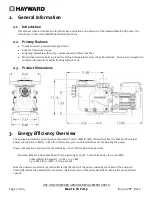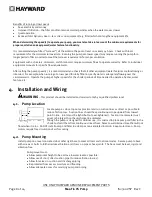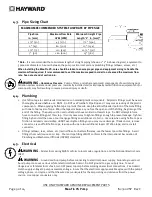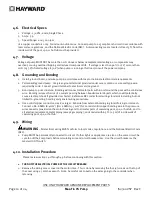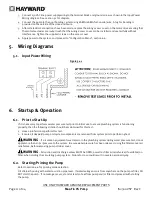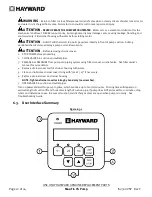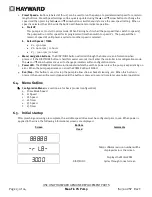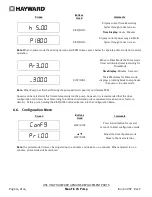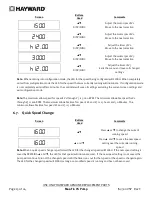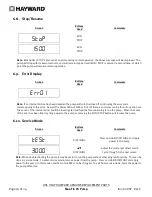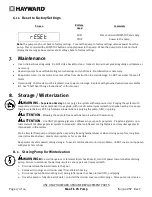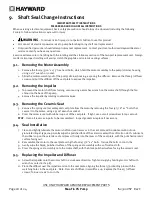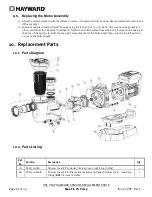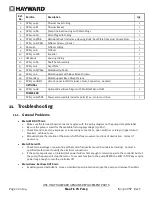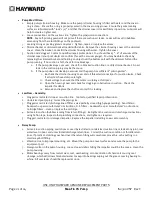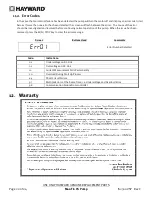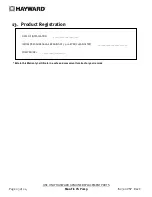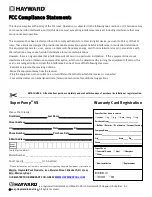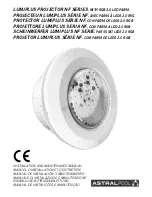
USE ONLY HAYWARD GENUINE REPLACEMENT PARTS
Page 21 of 24
Max-Flo VS Pump
IS2300VSP Rev C
Pump Won't Prime:
1.
Empty pump/strainer housing. Make sure the pump/strainer housing is filled with water and the cover o-
ring is clean. Ensure the o-ring is properly seated in the cover o-ring groove. Ensure the gasket sealing
surface is lubricated with “Jack’s 327” and that the strainer cover is locked firmly in position. Lubricant will
help to create a tighter seal.
2.
Loose connections on the suction side. Tighten the pipe/union connections.
NOTE
- Any self-priming pump will not prime if there are suction air leaks. Leaks will result in bubbles
emanating from the return fittings on the pool wall.
3.
Leaking O-ring or packing glands on valves. Tighten, repair, or replace the valves.
4.
Strainer basket or skimmer basket loaded with debris. Remove the strainer housing cover or the skimmer
cover. Clean the basket, and refill the strainer housing with water. Tighten the cover.
5.
Suction side clogged. Contact a qualified repair professional. You should have 5” - 6” of vacuum at the
strainer cover (your pool dealer can confirm this with a vacuum gauge). You may be able to check by
removing the skimmer basket and holding an object over the bottom port with the skimmer full and the
pump running. If no suction is felt, check for line blockage.
a.
If the pump develops a vacuum, check for a blocked suction line or a dirty strainer basket. An air
leak in the suction piping may be the cause.
b.
If the pump does not develop a vacuum and the pump has sufficient “priming water”:
i.
Re-check the strainer housing cover and all threaded connections for suction leaks. Check
if all system hose clamps are tight.
ii.
Check voltage to ensure that the motor is rotating at full rpm’s.
iii.
Open the housing cover and check for clogging or obstruction in suction. Check the
impeller for debris.
iv.
Remove and replace the shaft seal only if it is leaking.
Low Flow – Generally:
1.
Clogged or restricted strainer or suction line. Contact a qualified repair professional.
2.
Undersized pool piping. Correct the piping size.
3.
Plugged or restricted discharge line of filter, valve partially closed (high gauge reading). Sand filters –
backwash as per manufacturer’s instructions; D.E. filters – backwash as per manufacturer’s instructions;
Cartridge filters – clean or replace the cartridge.
4.
Air leak in suction (bubbles issuing from return fittings). Re-tighten the suction and discharge connections
using Teflon tape. Inspect other plumbing connections, and tighten as required.
5.
Plugged, restricted, or damaged impeller. Replace the impeller including a new seal assembly.
Noisy Pump:
1.
Air leak in suction piping, cavitations caused by restricted or undersized suction line or leak at any joint, low
water level in pool, and unrestricted discharge return lines. Correct the suction condition or throttle return
lines, if practical. Holding your hand over the return fitting will sometimes prove this, or by putting in a
smaller eyeball fitting.
2.
Vibration due to improper mounting, etc. Mount the pump on a level surface and secure the pump to the
equipment pad.
3.
Foreign matter in the pump housing. Loose stones/debris hitting the impeller could be the cause. Clean the
pump housing.
4.
Motor bearings noisy from normal wear, rust, overheating, or concentration of chemicals causing seal
damage, which will allow chlorinated water to seep into bearings wiping out the grease causing bearing to
whine. All seal leaks should be replaced at once.

